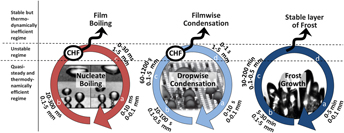Crossref Citations
This article has been cited by the following publications. This list is generated based on data provided by
Crossref.
Birbarah, Patrick
Li, Zhaoer
Pauls, Alexander
and
Miljkovic, Nenad
2015.
A Comprehensive Model of Electric-Field-Enhanced Jumping-Droplet Condensation on Superhydrophobic Surfaces.
Langmuir,
Vol. 31,
Issue. 28,
p.
7885.
Singha, Sanat K.
Das, Prasanta K.
and
Maiti, Biswajit
2015.
Thermokinetics of heterogeneous droplet nucleation on conically textured substrates.
The Journal of Chemical Physics,
Vol. 143,
Issue. 20,
Kim, Moon-Kyung
Cha, Hyeongyun
Birbarah, Patrick
Chavan, Shreyas
Zhong, Chen
Xu, Yuehan
and
Miljkovic, Nenad
2015.
Enhanced Jumping-Droplet Departure.
Langmuir,
Vol. 31,
Issue. 49,
p.
13452.
Boinovich, L. B.
Emelyanenko, A. M.
and
Emelyanenko, K. A.
2015.
Effect of Decanol Vapors on the Delay in Water Droplet Crystallization on Superhydrophobic Substrates.
The Journal of Physical Chemistry C,
Vol. 119,
Issue. 16,
p.
8718.
Wang, Tao
Jiang, Yu-Yan
Jiang, Hai-Chang
Guo, Cong
Guo, Chao-Hong
Tang, Da-Wei
and
Rong, Li-Jian
2015.
Surface with recoverable mini structures made of shape-memory alloys for adaptive-control of boiling heat transfer.
Applied Physics Letters,
Vol. 107,
Issue. 2,
Schutzius, Thomas M.
Jung, Stefan
Maitra, Tanmoy
Eberle, Patric
Antonini, Carlo
Stamatopoulos, Christos
and
Poulikakos, Dimos
2015.
Physics of Icing and Rational Design of Surfaces with Extraordinary Icephobicity.
Langmuir,
Vol. 31,
Issue. 17,
p.
4807.
Weisensee, Patricia B.
Neelakantan, Nitin K.
Suslick, Kenneth S.
Jacobi, Anthony M.
and
King, William P.
2015.
Impact of air and water vapor environments on the hydrophobicity of surfaces.
Journal of Colloid and Interface Science,
Vol. 453,
Issue. ,
p.
177.
Gouws, G J
and
Shortt, N
2015.
Microstructured silver surfaces produced by freeze casting for enhanced phase change heat transfer.
Journal of Physics: Conference Series,
Vol. 660,
Issue. ,
p.
012045.
Yang, Li-Xin
Chao, Yan-Meng
Jia, Li
and
Li, Chao-Bo
2016.
Wettability and boiling heat transfer study of black silicon surface produced using the plasma immersion ion implantation method.
Applied Thermal Engineering,
Vol. 99,
Issue. ,
p.
253.
Yamada, Yutaka
Takahashi, Koji
Ikuta, Tatsuya
Nishiyama, Takashi
Takata, Yasuyuki
Ma, Wei
and
Takahara, Atsushi
2016.
Tuning Surface Wettability at the Submicron-Scale: Effect of Focused Ion Beam Irradiation on a Self-Assembled Monolayer.
The Journal of Physical Chemistry C,
Vol. 120,
Issue. 1,
p.
274.
Patil, Nagesh D.
Bhardwaj, Rajneesh
and
Sharma, Atul
2016.
Droplet impact dynamics on micropillared hydrophobic surfaces.
Experimental Thermal and Fluid Science,
Vol. 74,
Issue. ,
p.
195.
Chavan, Shreyas
Cha, Hyeongyun
Orejon, Daniel
Nawaz, Kashif
Singla, Nitish
Yeung, Yip Fun
Park, Deokgeun
Kang, Dong Hoon
Chang, Yujin
Takata, Yasuyuki
and
Miljkovic, Nenad
2016.
Heat Transfer through a Condensate Droplet on Hydrophobic and Nanostructured Superhydrophobic Surfaces.
Langmuir,
Vol. 32,
Issue. 31,
p.
7774.
Vourdas, N.
Pashos, G.
Kokkoris, G.
Boudouvis, A. G.
and
Stathopoulos, V. N.
2016.
Droplet Mobility Manipulation on Porous Media Using Backpressure.
Langmuir,
Vol. 32,
Issue. 21,
p.
5250.
Wang, Zhangxin
Elimelech, Menachem
and
Lin, Shihong
2016.
Environmental Applications of Interfacial Materials with Special Wettability.
Environmental Science & Technology,
Vol. 50,
Issue. 5,
p.
2132.
Cha, Hyeongyun
Xu, Chenyu
Sotelo, Jesus
Chun, Jae Min
Yokoyama, Yukihiro
Enright, Ryan
and
Miljkovic, Nenad
2016.
Coalescence-induced nanodroplet jumping.
Physical Review Fluids,
Vol. 1,
Issue. 6,
Frankiewicz, C.
and
Attinger, D.
2016.
Texture and wettability of metallic lotus leaves.
Nanoscale,
Vol. 8,
Issue. 7,
p.
3982.
Stamatopoulos, Christos
Schutzius, Thomas M.
Köppl, Christian J.
Hayek, Nicolas El
Maitra, Tanmoy
Hemrle, Jaroslav
and
Poulikakos, Dimos
2016.
On the shedding of impaled droplets: The role of transient intervening layers.
Scientific Reports,
Vol. 6,
Issue. 1,
Jones, Paul R.
Elliott, Ashley R.
and
Patankar, Neelesh A.
2016.
Sustaining Superheated Liquid within Hydrophilic Surface Texture.
Langmuir,
Vol. 32,
Issue. 48,
p.
12947.
Kanatani, Kentaro
and
Oron, Alexander
2016.
Nonlinear effect of surface disturbances on mass flux and its modeling in Marangoni dropwise condensation.
International Journal of Heat and Mass Transfer,
Vol. 94,
Issue. ,
p.
419.
Ganne, Agatha
Lebed, Valeria O.
and
Gavrilov, Anton I.
2016.
Combined wet chemical etching and anodic oxidation for obtaining the superhydrophobic meshes with anti-icing performance.
Colloids and Surfaces A: Physicochemical and Engineering Aspects,
Vol. 499,
Issue. ,
p.
150.
